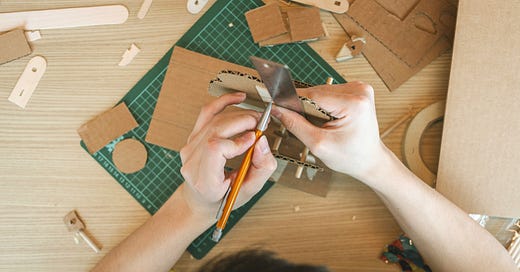I write about the importance of growth mindsets for creativity and research showing that creativity attitudes and skills can be learned. I have even developed and tested programs that can help build creativity.
So, I was very excited when my son’s elementary school adopted a STEAM program. The school was going to teach creativity.
They started with divergent thinking games. Think of all the uses for … a shoe… a knife… tin can.
This was fun and fun is important. But it was also a missed opportunity.
Because there was no observation or reflection about it. Children could have learned that the first ideas are not the most creative ones. When I spoke with my son, then and since, I would tell him that if I could only impart one lesson about creativity it would be that the first ideas are rarely the best.
Research shows that people’s intuition about the flow of ideas and the reality are in exact opposition. People think that their first ideas are the most creative perhaps because of the belief that the spark of creativity matters above all. Because these ideas can be experienced having come upon them.
As I have been doing the grand tour of creativity-related podcasts with The Creativity Choice, I noticed that this fact about creative ideas seems counterintuitive even to experienced creators. Seems. But once the conversation gets going and they reflect on the creative process, it quickly become clear that indeed the initial ideas change, evolve, and are even often completely abandoned for something completely different in the course of creative work.
This would have been a great lesson to teach 3rd graders.
Also, this is rather liberating. If your first idea is not great, it is not because you were not endowed by magic creativity fairy dust and it does not mean you will not produce anything of value. It means that you have to continue thinking and working. With effort and engagement with the problem, ever better ideas will emerge.
What students learned from divergent thinking games is that creative thinking can go in different directions and have many answers. But they did not learn that the mind starts with what is obvious and gets more original as we persist.
Another exercise in this STEAM program was a design challenge. Students were asked to devise a way for a gondola to travel a short distance carrying a small object and they were provided materials they could use.
There was a catch. Students were not allowed to play with the materials. Instead, they were asked to think about it and write down step by step what they would do to build the gondola. Planning is one of the skills of executive functioning and teachers wanted to teach both creativity and executive functioning.
The trouble is that planning does not work in the creative process in this form.
The students tried, but failed. Of course they failed. It is simply not possible to plan creative work step by step. And it is not possible to do something creative without playing with the materials, feeling them, trying them out, experimenting with one combination and then another.
Process of experimentation is important for artists putting together a still life drawing, for start ups comparing different features of their products, and for professional designers at work. How much people do it makes a big difference. Artists who spend more time in this process of playing with art objects create pieces judged by art professors and critics as more creative. Startups that do it have 20-40% greater chance of surviving.
I am not sure what students learned in this challenge. My son concluded that he was not good at it. I suspect other students might have gotten the same message.
But researchers have shown that professional designers who were not allowed to physically manipulate their materials did not tend to be successful either. Not because they were not capable, but because such manipulation is necessary for successful creativity.
Let’s go back to that elementary school classroom. What if the next day students worked on a design challenge by being encouraged to explore building materials? They could have seen the difference in outcomes without play and with it and learned that exploration is not frivolous, but a way to solve problems creatively.
That was a missed teaching opportunity. Not because of bad teachers. These were exceptionally caring teachers who realized the importance of creativity. Rather, because teachers are themselves not taught about the nature of creativity.
So we continue taking myths about creativity with us to the world of work. Unless we are proactive in learning the lessons we might have missed. Growth mindset in action.






Pina Bauch, the internationally celebrated choreographer, used the method of having dancers create 6 responses to a task or provocation - eg show 6 ways of expressing love without moving your feet … - knowing that the first responses are the most pedantic usually and the later responses are the most whimsically creative … also by providing a limitation eg standing still … it forces the brain to play outside the square. I love the notion that educators are giving attention to the tricky notion of teaching creativity … like creativity itself you only learn by doing and exploring and getting discombobulated in the process :)
You’ve articulated what so many educators intuit but often don’t have the language or training to fully express: that creativity isn’t a flash, it’s a process. And that process requires space. Space to explore, to reflect, to revise. We see this daily in the schools we work with—how the physical environment can either constrain or unleash that kind of iterative thinking. Thank you for naming this missed opportunity not as failure, but as a chance to redesign how we teach creativity, starting with what we model in the room itself!